

MSN.com. Magic Number for SaaS Companies. Guest post by Lars Leckie.
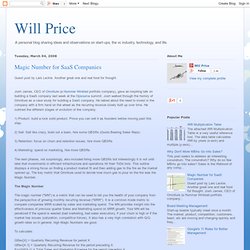
Another great one and real food for thought. Josh James, CEO of Omniture (a Hummer Winblad 1) Product: build a rock solid product. Prove you can sell it as founders before moving past this step. 2) Sell: Sell like crazy, build out a team, hire some QBSRs (Quota Bearing Sales Reps) 3) Retention: focus on churn and retention issues, hire more QBSRs 4) Marketing: spend on marketing, hire more QBSRs The next phases, not surprisingly, also included hiring more QBSRs but interestingly it is not until later that investments in efficient infrastructure and operations hit their ToDo lists. Business Case: SaaS Rules of Thumb. News Business Case: SaaS Rules of Thumb The transition to Software as a Service (SaaS) has appeared imminent for a few years, but the shift has flowed more like a glacier than a flood.
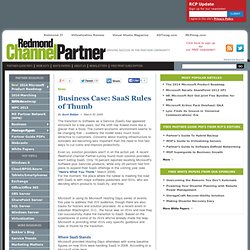
The current economic environment seems to be changing that -- suddenly the model looks much more attractive to customers. Concerns about trusting infrastructure to outsiders are becoming less important than the need to find fast ways to cut costs and improve productivity. Even so, solution providers aren't in on the action yet. Microsoft is using its Microsoft Hosting Days series of events this year to address that ISV audience, though there are also tracks for hosters and solution providers.
Where SaaS Stands Microsoft provided Hosting Days attendees with some baseline figures on how ISVs were handling SaaS in 2008. On the multi-tenant versus single-tenant architecture technical question, it's a 50-50 toss up. (Annual revenue goal)/78 * (# of months left in the fiscal year) SaaS « Non-Linear Growth. The “Leo the Late Bloomer” of Business Models My kids love the book “Leo the Late Bloomer”.
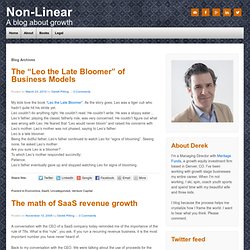
As the story goes, Leo was a tiger cub who hadn’t quite hit his stride yet. Leo couldn’t do anything right. He couldn’t read. He couldn’t write. The math of SaaS revenue growth. A conversation with the CEO of a SaaS company today reminded me of the importance of the rule of 78s.
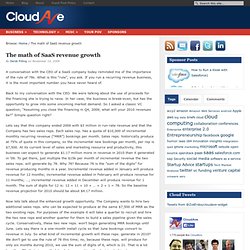
What is this “rule”, you ask. If you run a recurring revenue business, it is the most important number you have never heard of. Back to my conversation with the CEO. We were talking about the use of proceeds for the financing she is trying to raise. In her case, the business is break-even, but has the opportunity to grow into some oncoming market demand. Lets say that this company ended 2009 with $3 million in run-rate revenue and that the Company has two sales reps. Now lets talk about the enhanced growth opportunity. While this looks like meager growth, it doesn’t tell the whole story. Here are the key takeaways: 1) Get the Base Right: Recurring-revenue businesses are great because they are highly predictable. 3) Run-Rate Matters: You will see the impact of an investment in sales and marketing in run-rate much faster than in top-line GAAP revenues.
Related posts: Bessemer SaaS Law #3. Bessemer SaaS Law #3.
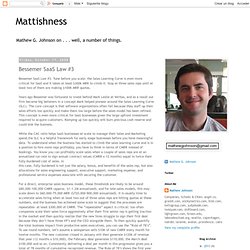
Tune before you scale: the Sales Learning Curve is even morecritical for SaaS and it takes at least $300k MRR to climb it. Stop at three sales reps until at least two of them are making $100K MRR quotas. Years ago Bessemer was fortunate to invest behind Mark Leslie at Veritas, and as a result our firm became big believers in a concept Mark helped pioneer around the Sales Learning Curve (SLC). The core concept is that software organizations often fail because they staff up their sales efforts too quickly and make them too large before the sales model has been refined.
This concept is even more critical for SaaS businesses given the large upfront investment required to acquire customers. While the CAC ratio helps SaaS businesses at scale to manage their Sales and Marketing spend,the SLC is a helpful framework for early stage businesses before you have meaningful data. Telecom Recurring Revenue Forecasting … what is the rule of 78’s?Business Tools Blog. Republishing - originally published on 4/28/08.

The rule of 78’s is a simple math for those who need to estimate recurring revenue or recurring expense over the next 12 months. For example, Jim Crowe, Level 3 CEO, used the rule of 78’s to explain Level 3’s revenue on the Q1 2008 Earnings Call. Formula – (Current run rate) + (average monthly net installs * 78) = full year revenue or expense Why does it work? When you install a $1 of recurring revenue on January 1st, you will receive $1 of revenue every month for that year. For those who like tables, see below: This is why installing revenue sooner is so important.